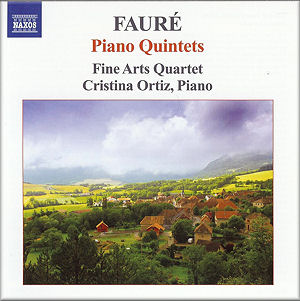 |
 |
|


alternatively
CD: AmazonUK
AmazonUS
Download: Classicsonline
|
Gabriel FAURÉ
(1845-1924)
Piano Quintet No.1 in D minor, Op.89 (1887-1906) [30:59]
Piano Quintet No.2 in C minor, Op.115 (1919-1921) [32:17]
 Fine
Arts Quartet (Ralph Evans, Efim Boico (violins), Yuri Gandelsman (viola),
Wolfgang Laufer (cello)); Cristina Ortiz (piano) Fine
Arts Quartet (Ralph Evans, Efim Boico (violins), Yuri Gandelsman (viola),
Wolfgang Laufer (cello)); Cristina Ortiz (piano)
rec. December 2007, Purchase College, New York, USA
 NAXOS 8.570938 [63:24]
NAXOS 8.570938 [63:24]  |
|
|
Fauré's Piano Quintets are very different from his more
popular Piano Quartets, which were written much earlier and
storm the heights and depths of High Romanticism. The Quintets
are sublime, but elusive. They are warm and comfy, like climbing
with your feet into an armchair in front of a fireplace. The
emotions are reticent, all is calm, you sense the soft smile
of a wise old man. Sometimes it is a sad smile, a sorrow, a
regret.
Unusually the piano part sings with the string parts. This is
no concerto for piano and reduced orchestra. Here, the performers
work together to create a perfect, seamless blend. Sometimes
the piano part is purposefully sparse, economical - its utterances
calculated with precise craft. All this results in an hour of
ethereal sonorities, which will deliver great pleasure once
you stop looking for contrast between movements.
The two Quintets have gentle autumnal qualities that may remind
of the late clarinet chamber pieces of Brahms. The opening movement
of the First Quintet is somewhat Brahmsian, yet it radiates
a singing beauty that only the French knew how to produce. The
long Adagio that follows is more subdued and melancholic,
yet its climaxes are highly emotional, and its quiet moments
are magical. The last movement, a scherzo and finale in one,
starts with a distant echo of Eroica variations, with
subsequent episodes that are by turns ecstatic, stormy and sunny.
Finally, the swirling coda swirls all the notes into one bold
D-major.
Although the Quintet No.2 was written when Fauré was
75, it shows no decrease in vigor, sharp wit, or inspiration.
The first movement is unmistakable Fauré. It is so similar
emotionally to the first movement of the first Quintet that
it is hard to believe that fifteen years have passed, a war
has swept through France, and Les Six have started their collaboration.
The formal structure is complex, but in the master's hands this
complexity is transparent: the metamorphoses of music seem to
obey the hidden laws of nature. The Scherzo second movement
looks even further back, to the Piano Quartets of forty years
before. After all, Fauré was the father of the "French
scherzo", employed by Debussy and Ravel in their chamber
pieces. Now the music is drier, and for a long time there is
a sense of expectation for a big romantic resolution which does
not arrive until the very last measures. This is suspense without
climax - an enthralling effect, like watching a swift, turbulent
stream.
The slow movement is a vast, quasi-static tableau. It has a
feeling of timelessness, reminiscent of Beethoven's Song
of Thanksgiving from Op.132. When it is over, and the
finale starts, it is like emerging from a hypnotic trance. And
what a gloomy wakening it is. The more cheerful moments are
like nostalgic memories, or viewing the emotions of youth from
the vantage point of old age. The cold, bumpy rolling of the
piano part underlines the fatalism. The sun often breaks through
the clouds and the coda brings bright sunlight. Thus the Quintet
ends on an optimistic note, though that's not what remains in
mind: the wind and rain remain. This belongs amongst the most
memorable music you can find in the chamber realm.
When I took this disc for review I was interested whether someone
could trounce my old favorite - Domus on Hyperion (CDA66766,
rec.1994). And the answer is - yes and no. 'No' - in tone, but
probably 'yes' in intensity, especially in the Second Quintet.
The Hyperion recording has a certain clear-water sound that
is not easily explained. Imagine drinking from the most fresh
forest source: you can drink, and drink, and still want more,
and not get tired. I don't know how the Domus (plus Anthony
Marwood on 2nd violin) achieved this, but that's the feeling
I have. On the Naxos disc, the piano of Christina Ortiz has
similar transparent delicacy, but the string instruments have
more ordinary sound, which, listening for an hour, can tend
to tire the listener.
On the other hand, this is just a matter of tone, a personal
preference. Objectively I cannot pinpoint a weak spot in this
Naxos incarnation. The quintets are played with great devotion,
showing fine balance and rich in delicate nuance. The ensemble
is perfect, which is as expected from such an experienced group
as the Fine Arts. The differences from Domus/Marwood are more
noticeable in the Second Quintet, where I prefer the choices
made by the Fine Arts and Ortiz. The recording quality is first
class, both clean and atmospheric.
Another fine disc from Naxos.
Oleg Ledeniov
see also reviews by Ian
Lace and Kevin
Sutton
|
|
|

